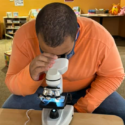“The Lovely Bones” by Alice Sebold, 328 pages, Little, Brown & Company.
In a world in which little girls can disappear from street corners or even their own bedrooms, perhaps it isn’t surprising that this novel is being so widely read.
But the sheer inventiveness of the concept — “The Lovely Bones” is written in the voice of a 14-year-old victim of a rape and murder from her vantage point in heaven — is also drawing readers.
Both the critics and the general reading public are right in snapping up this beautifully written novel. It comforts the reader by acknowledging that there is a heaven, a place where little girls taken from their schoolgirl crushes and pop music go on living. And it shows that survivors can make new lives for themselves, even if it takes years and constant, excruciating heartache. There is light at the end of the tunnel, both here on earth and in heaven.
If perhaps the concept sounds uninviting, it is not. It is a book full of hope, of human connection and caring, of familial ties that cannot be broken.
The year is 1973, the season is winter and the setting is a small town where the most horrible thing that should be happening is someone not getting invited to the Saturday night sleepover.
But, from the first paragraph, the story draws you in: “My name was Salmon, like the fish; first name, Susie. I was 14 when I was murdered on Dec. 6, 1973. In newspaper photos of missing girls from the ’70s, most looked like me: white girls with mousy brown hair.”
And you’re hooked. You absolutely must read this to the end, as quickly as possible because you have to find out what happens.
Susie Salmon is a wonderfully complex character: she was a member of the chess club and considers herself literary. She has the love-hate relationship with her slightly younger sister that most female siblings do, and she dotes on her much younger brother yet, at the same time, considers him a pest when she has to baby-sit him.
She’s a daddy’s girl, one who loves to sit with him in the study and watch him build ships in bottles. After her disappearance, he grieves visibly and angrily, pointing out to the police the neighbor he thinks — rightly — has killed his daughter. He has no evidence; they don’t believe him.
Susie’s mother is built out of the same material as some other literary mothers facing the deaths of their children; she most closely resembles the emotionally-closed mother of the boy who drowned in Judith Guest’s “Ordinary People.”
Susie watches as her mother tries to close out the pain, first becoming emotionally numb, then having a desperate affair with the police detective investigating the case. Eventually, she bolts.
There’s the sister who starts wearing Susie’s clothing, the little brother who eventually reveals he still sees her sometimes, the best friend who’s a bit wild and gets wilder in her grief.
The Salmon family lives with hope after Susie disappears; all that is found of her is an elbow. They delude themselves, thinking how she could easily live life without an arm.
The boy who loved her and with whom she shared the only chaste kiss of her short life is, at first, considered a suspect, until it’s learned that he was with his father at the time of her death and was seen by many other people.
The most complicated relationship is one that, in life, almost didn’t exist. It is of Ruth, the artistic unpopular girl, who happened to be walking past the cornfield at the time Susie was killed and who was briefly touched by her soul as it wildly escaped into the hereafter. Ruth becomes obsessed by Susie — and begins developing an ability to recognize the spots everywhere around her where girls and women have been hurt or killed. She becomes a psychic lightning rod for roiling storms of feminine pain. She sees ghosts.
And, as each of these lives meanders along on its own path that sometimes intersects with that of others, Susie sees it all. She’s watching from heaven, a place of her own creation. It looks like a beautiful suburban high school where the textbooks are Seventeen and Glamour. There are the scents she loves and a little duplex she shares with another young girl who has also died but whose idea of heaven is similar.
But the one thing Susie wants — to continue to live her life — is impossible. This heaven, you feel, is just a first way-station, a place to work out the connections so you can advance into another. At first, apparently, in author Sebold’s world, our personal myths of heaven come to be.
Her new situation makes her sad, but she also lives vicariously through her sister, watches as a boy that perhaps her parents wouldn’t at one time have chosen for her becomes someone who seems heaven-sent.
Having a narrator who sees what is happening with each of the characters and who knows all their secrets is completely involving. It’s an excellent way to handle authorial omniscience.
We know right away that it was Mr. Harvey, the neighbor, who killed Suzie Salmon. We know he lured her into a room built into the earth in the middle of a cornfield just behind the junior high she attends.
Like Suzie, we know all, see all.
This is the most extraordinarily imaginative novel to come out in years. It is moving, tender and seems, somehow, very true. It’s hard to conceive of a reader who wouldn’t enjoy it.
“The Lovely Bones” has mystery, pathos, humor, sorrow, romance, longing — you name it. This book is bound to be one of the runaway best sellers of the year. And it deserves our attention. It is healing and — you may not believe this — joyful. With such an unlikely premise, it still rings true.
Read it before they turn it into a movie. The book is always better.
(Editor’s note: The book was No. 1 on the New York Times fiction best-sellers list this week.)















